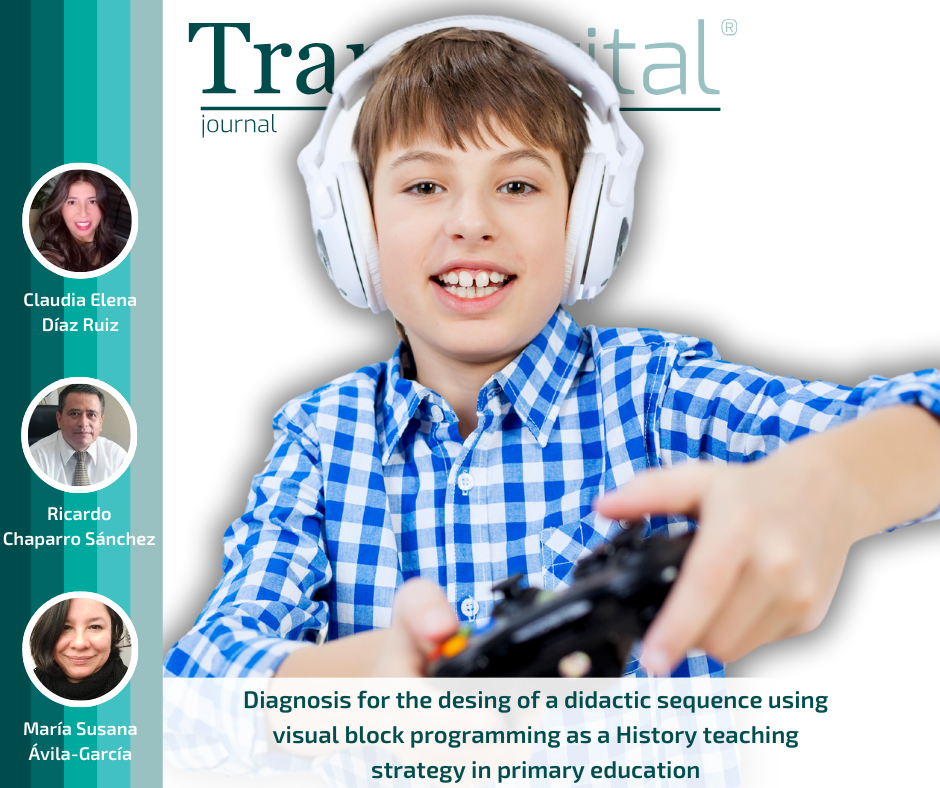Diagnosis for the desing of a didactic sequence using visual block programming as a History teaching strategy in primary education
DOI:
https://doi.org/10.56162/transdigital269Keywords:
educative innovation, educative technology, experimental teaching, educative researchAbstract
According to specialized literature, educational institutions at all educational levels are constantly seeking new teaching strategies to motivate and consolidate meaningful learning in students. The use of video games in education is a relatively recent trend and, as it is based on the principles of gamification, it has presented positive results on meaningful learning. This text presents the results of the diagnosis phase that allow us to assess whether it is possible, subsequently, to design a didactic sequence for a thematic unit of the subject of History, which involves the development of a video game using visual block programming as a technological tool based in gamification. This diagnosis was applied in an educational institution in the central area of ??Veracruz, Mexico. The field of study was primary education. Three questionnaires were applied: 1) Teacher digital literacy questionnaire; 2) Student technological skills questionnaire; 3) Technological infrastructure questionnaire. The findings suggest that there must be a technological update in the institution; Teachers are willing to incorporate digital technology into their teaching processes, but they require knowledge of block programming; Students show sufficient skills to participate as video game content creators. In conclusion, there are favorable conditions to propose an educational innovation strategy that involves video games as a teaching resource for teaching History at the primary level.
References
Aranda Martín, D. (2020). Diseño de una propuesta de intervención para el desarrollo de las inteligencias múltiples a través del uso de videojuegos y realidad virtual dentro de un aula de educación primaria [Tesis de máster]. Facultad de Educación de la Universidad de la Rioja, España. https://reunir.unir.net/handle/123456789/10792
Díaz Cruzado, J., & Troyano Rodríguez, Y. (2013). El potencial de la gamificación aplicado al ámbito educativo. Universidad de Sevilla. Facultad de Ciencias de la Educación. En III Jornadas de Innovación Docente. Innovación Educativa: respuesta en tiempos de incertidumbre. Facultad de Ciencias de la Educación de la Universidad de Sevilla, España. http://hdl.handle.net/11441/59067
Gardner, H. (1983). Frames of Mind: The Theory of Multiple Intelligences. Basic Books.
Kabak, K., & Korucu, A. T. (2021). The effect of students' developing their own digital games on their academic achievement and attitudes towards for English lessons. Participatory Educational Research, 8(2), 74-93. https://doi.org/10.17275/per.21.30.8.2
Morillas, C. (2016). Gamificación de las aulas mediante las TIC: Un cambio de paradigma en la enseñanza presencial frente a la docencia tradicional [Tesis doctoral] Universidad Miguel Hernández de Elche, España.
Pertejo, J. (2017). Programación gráfica y robótica para fomentar la competencia matemática [Tesis de fin de grado] Universidad Internacional de la Rioja, España. https://reunir.unir.net/bitstream/handle/123456789/5717/PERTEJO LOPEZ%2C JUDITH.pdf?sequence=1&isAllowed=y
Roncancio-Ortiz, A. P., Ortiz-Carrera, M. F., Llano-Ruiz, H., Malpica-López, M. J., & Bocanegra-García, J. J. (2017). El uso de los videojuegos como herramienta didáctica para mejorar la enseñanza-aprendizaje: una revisión del estado del tema. Ingeniería Investigación y Desarrollo, 17(2), 36–46. https://doi.org/10.19053/1900771X.v17.n2.2017.7184
Sáez López, J. M. & Cózar Gutiérrez, R. (2016). Pensamiento computacional y programación visual por bloques en el aula de Primaria. Educar, 53(1), 129-146. https://doi.org/10.5565/rev/educar.841
Sánchez Pacheco, C., García Balladares, E., & Ajila-Méndez, I. (2020). Enfoque pedagógico: la gamificación desde una perspectiva comparativa con las teorías del aprendizaje. 593 Digital Publisher CEIT, 5(4). 47-55. https://doi.org/10.33386/593dp.2020.4.202
Solano Nogales, L., & Santacruz Valencia, L. (2016). Videojuegos como herramienta en Educación Primaria: caso de estudio con eAdventure. TE & ET: Revista Iberoamericana de Tecnología en Educación y Educación en Tecnología, (18), 101-112. http://sedici.unlp.edu.ar/handle/10915/58515
Torres Toukoumidis, Á. & Romero-Rodríguez, L. M. (2018). Aprender jugando. La gamificación en el aula. En R. García, A. Pérez & A. Torres (Eds.), Educar para los nuevos medios (pp. 61-72). Abya-Yala.
Valverde Berrocoso, J., Fernández Sánchez, M. R. & Garrido-Arroyo, M. C. (2015). El pensamiento computacional y las nuevas ecologías del aprendizaje. Revista de Educación a Distancia (RED), 46(3). https://doi.org/10.6018/red/46/3

Downloads
Autor de correspondencia
El autor de correspodencia se identifica con el siguiente símbolo: *Published
How to Cite
License
Copyright (c) 2024 Claudia Elena Díaz Ruiz, Ricardo Chaparro Sánchez, María Susana Ávila-García

This work is licensed under a Creative Commons Attribution 4.0 International License.
All articles in Transdigital are licensed under a Creative Commons Attribution 4.0 International License. Authors hold the copyright and retain publishing rights without restrictions.









